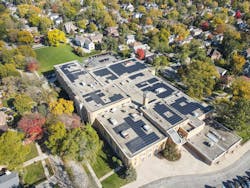Renewable developer, EPC firm install 2,000 Solar panels atop schools at Chicago-area District
A Chicago-area school district has four new rooftop solar projects installed at most of its sites in Cook County.
Solar developer White Pine Renewables announced that the installations are completed for the La Grange School District 102. The nearly 1 MW of photovoltaic panels are the first on-site solar projects contributing to electricity for the school district under a long-term power purchase agreement.
Renewables engineering, procurement and construction firm New Chicago built the projects. Those include 2,000 rooftop solar PV panels across four of the district’s six schools in Chicago’s western suburbs. White Pine Renewables and New Chicago will provide long-term operations and maintenance services through the life of the PPA contract.
“The La Grange School Board began exploring solar for our schools for the purpose of reducing our costs and enhancing education for our students,” Kyle Schumacher, La Grange Superintendent of Schools, said in a statement. “These projects achieved both objectives without an upfront investment from the district.”
The solar panels are located on rooftops at Congress Park, Ogden Avenue, Forest Road and Park Junior High schools.
Last year, New Pine Renewables completed a 4.78-MW floating solar power project for the city of Healdsburg, California. The Healdsburg solar panels are sited on ponds at the city’s wastewater treatment plant and was heralded as the large floating solar project completed in the U.S. by that time.
The U.S. Energy Information Administration forecast that utility-scale and distributed solar installations will top all other types of power generation added in 2022. The C&I Energy Transition includes dozens of on-site solar PV projects for commercial operations, military bases, education campuses, health care facilities and industrial sites.
-- -- --
(Rod Walton, senior editor for EnergyTech, is a 14-year veteran of covering the energy industry both as a newspaper and trade journalist. He can reached at [email protected]).
About the Author
Rod Walton, EnergyTech Managing Editor
Managing Editor
For EnergyTech editorial inquiries, please contact Managing Editor Rod Walton at [email protected].
Rod Walton has spent 17 years covering the energy industry as a newspaper and trade journalist. He formerly was energy writer and business editor at the Tulsa World. Later, he spent six years covering the electricity power sector for Pennwell and Clarion Events. He joined Endeavor and EnergyTech in November 2021.
Walton earned his Bachelors degree in journalism from the University of Oklahoma. His career stops include the Moore American, Bartlesville Examiner-Enterprise, Wagoner Tribune and Tulsa World.
EnergyTech is focused on the mission critical and large-scale energy users and their sustainability and resiliency goals. These include the commercial and industrial sectors, as well as the military, universities, data centers and microgrids. The C&I sectors together account for close to 30 percent of greenhouse gas emissions in the U.S.
He was named Managing Editor for Microgrid Knowledge and EnergyTech starting July 1, 2023
Many large-scale energy users such as Fortune 500 companies, and mission-critical users such as military bases, universities, healthcare facilities, public safety and data centers, shifting their energy priorities to reach net-zero carbon goals within the coming decades. These include plans for renewable energy power purchase agreements, but also on-site resiliency projects such as microgrids, combined heat and power, rooftop solar, energy storage, digitalization and building efficiency upgrades.

